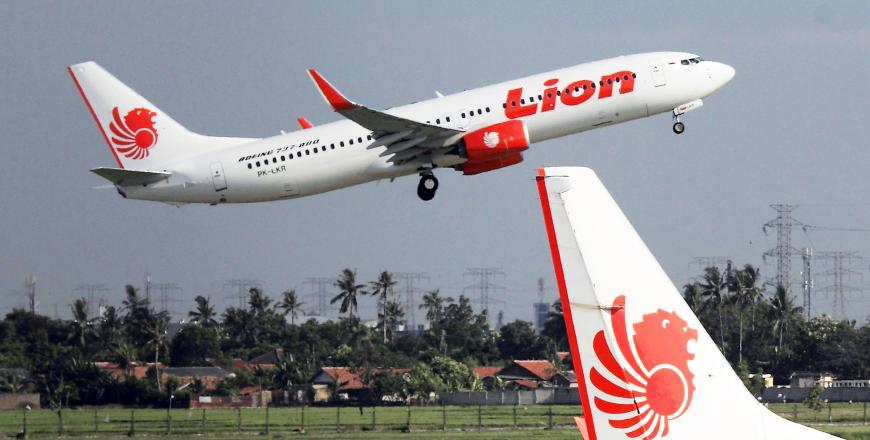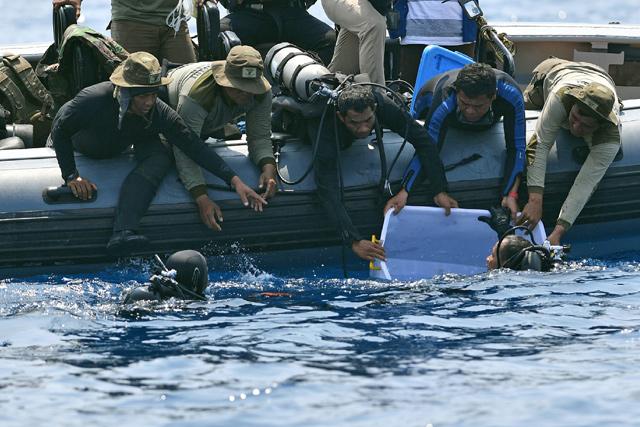You are here
Indonesia extends search for victims of jet crash
By Reuters - Nov 07,2018 - Last updated at Nov 07,2018

Investigators examine engine parts from the ill-fated Lion Air flight JT 610 at a port in Jakarta, on Wednesday, after they were recovered from the bottom of the Java Sea (AFP photo)
JAKARTA — Indonesian authorities extended on Wednesday a search for victims of the plane crash last week, when all 189 on board a Lion Air flight were killed, and for the aircraft’s second black box, the cockpit voice recorder.
The nearly new Boeing Co. 737 MAX passenger plane slammed into the sea on October 29, only minutes after take-off from Jakarta, en route to Bangka Island near Sumatra.
“We have extended the operation for three more days,” Muhammad Syaugi, the head of the national search and rescue agency (Basarnas), told Reuters.
It was the second time the search has been extended.
But he said search teams from the military, police and others would stand down, leaving just his agency to press on.
“This operation has been running for 10 days and the results from combing the sea surface and the seabed are declining, therefore the resources of Basarnas should be sufficient,” Syaugi told a news conference.
Basarnas had 220 personnel, including 60 divers, as well as four ships involved in the search and were focusing on an area with a radius of 250 metres, he said.
A police official said 186 body bags containing human remains had been retrieved and 44 victims identified after forensic examination.
Authorities have downloaded data from one of the black boxes found last week, the flight data recorder, but are still looking for the cockpit voice recorder
“A ‘ping’ has been detected from the second black box but the signal was very weak, possibly because it was encased in mud,” said Nurcahyo Utomo, an air accident official at the transportation safety committee (KNKT).
A vessel capable of sucking up mud was likely to be brought in to help, he told a news conference.
Boeing said on Wednesday it had issued a safety bulletin reminding pilots how to handle erroneous data from a sensor in the wake of the Lion Air crash.
The US plane-maker said investigators looking into the Lion Air crash had found that one of the “angle of attack” sensors on the aircraft had provided erroneous data.
Experts say the angle of attack is a crucial parameter that helps the aircraft’s systems understand whether its nose is too high relative to the current of air — a phenomenon that can throw the plane into an aerodynamic stall and make it fall.
KNKT said that there was a problem with the sensor on the last flight taken by the doomed plane, from the island of Bali to Jakarta, even though one sensor had been replaced in Bali.
The KNKT has interviewed crew and technicians on duty for two previous flights, while also retrieving the faulty sensor from Bali for inspection.
KNKT is planning to simulate a flight to assess the impact of sensor damage at Boeing’s engineering simulator facility in Seattle.
Related Articles
PAKISJAYA- An Indonesian aircraft with 189 people on board crashed into the sea and sank on Monday soon after taking off from the capital, J
JAKARTA — The pilot of a Lion Air flight from Indonesia's Bali island on Sunday made a radio alert minutes after take-off due to technical p
NAIROBI — An Ethiopian Airlines Boeing 737 passenger jet to Nairobi crashed early on Sunday, killing 149 passengers and eight crew, the airl



















